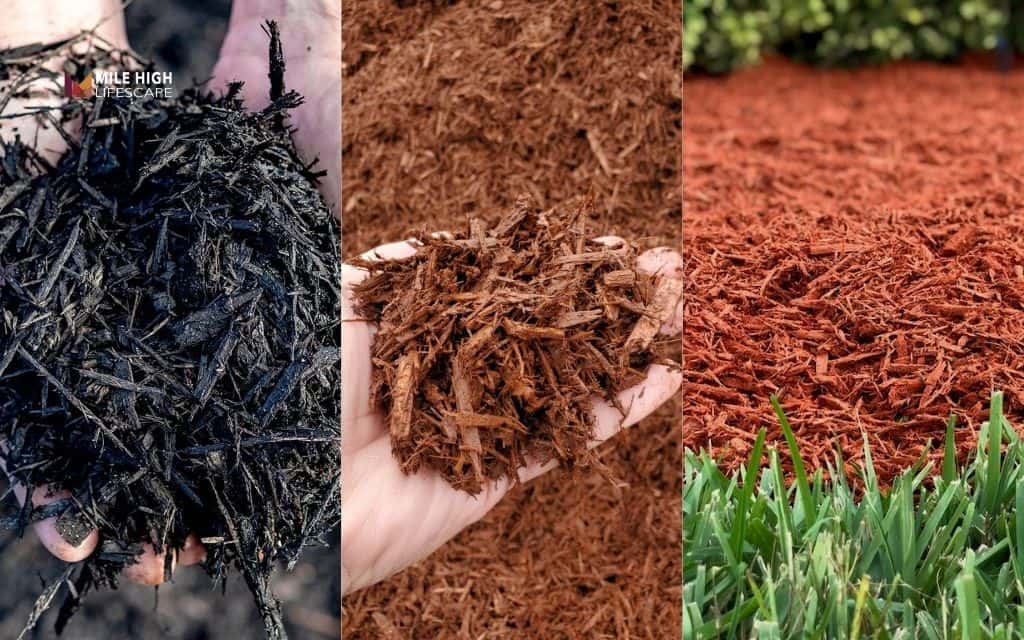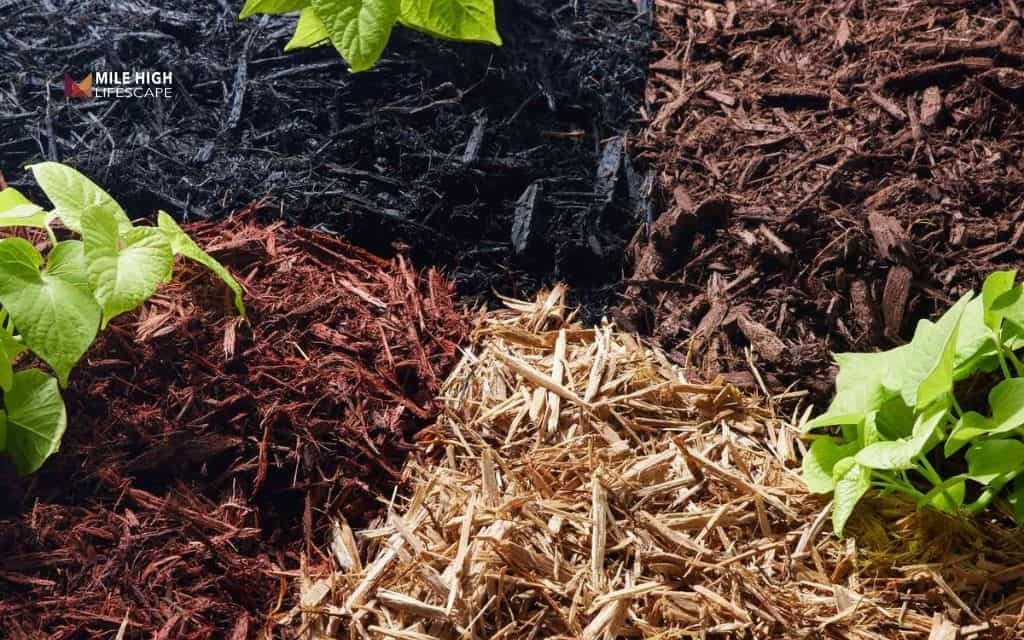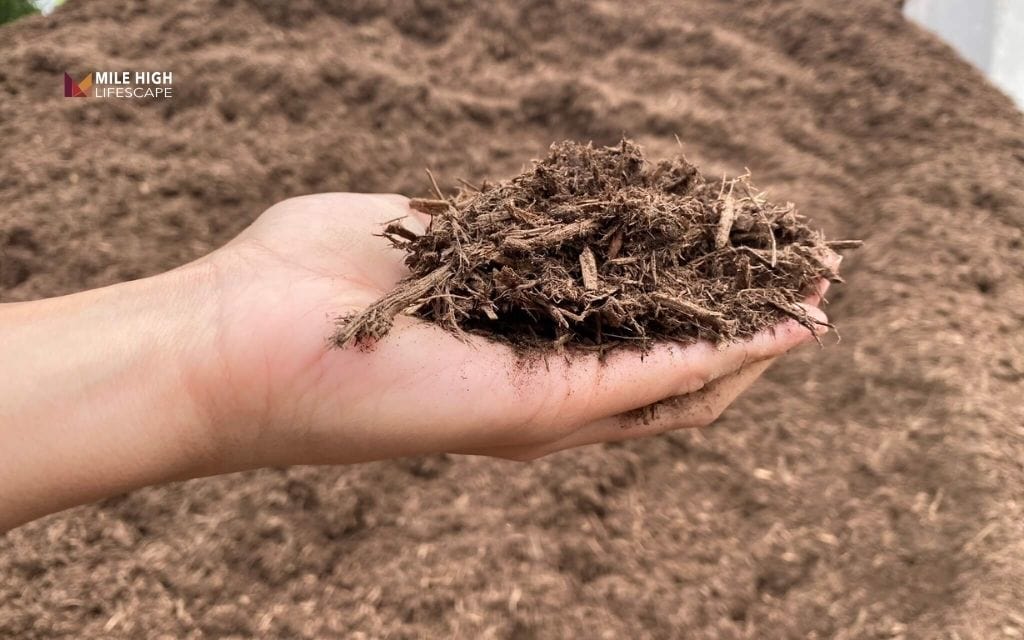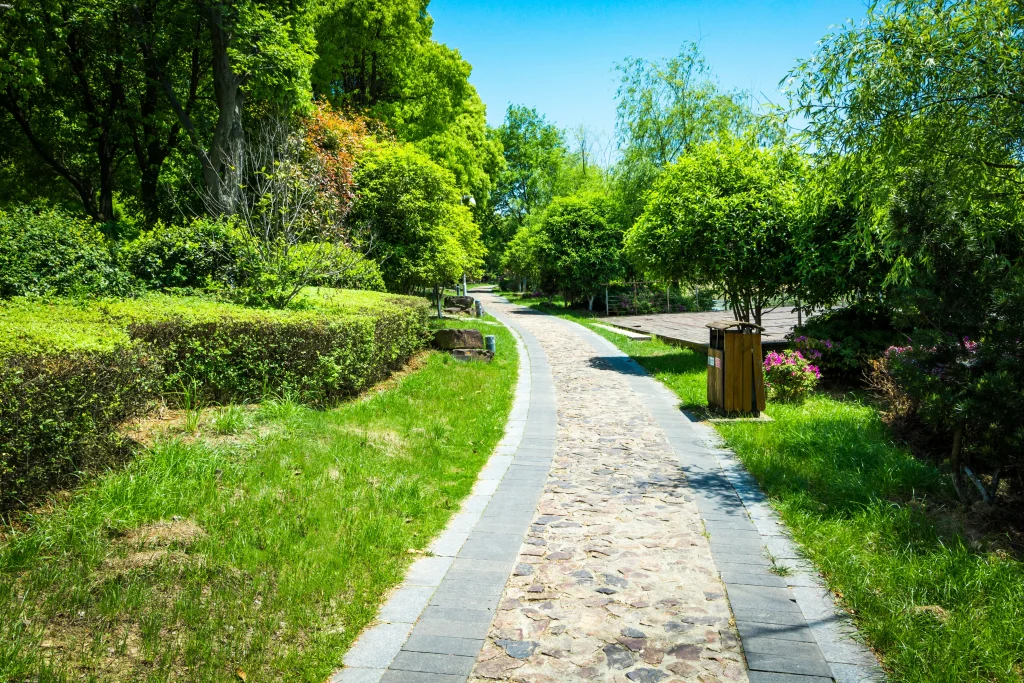What color mulch looks best in your yard? This choice affects more than you might think. Mulch color shapes your home’s curb appeal. It determines whether your plants stand out or blend in. The wrong color can make your landscape look dated or chaotic. The right one creates an intentional, polished appearance that lasts.
This guide will help you, as a Denver homeowner, to:
- Choose the best mulch color that complements your garden style
- Avoid common color mistakes that look dated or clash with your landscape
- Make a smart choice that still looks intentional and polished after several seasons
Why mulch color matters
Curb appeal and first impressions
Your mulch color is one of the first things visitors notice as they approach your home.
A well-chosen color makes your landscape look deliberate. People notice the clean lines and the way plants pop against the ground cover. The whole scene feels finished and maintained.
The wrong color does the opposite. Red mulch against a gray house creates visual noise. Black mulch in a cottage garden feels out of place. These mismatches tell visitors that something is off, even if they can’t name what it is.
Contrast, depth, and focal points
Dark mulch makes green foliage and bright flowers stand out. The contrast draws your eye to the plants, not the ground. This works especially well with white petunias, yellow daylilies, or deep green hostas.
Lighter tones create a softer look. Natural brown mulch blends with the soil. It lets the entire garden feel cohesive rather than divided into separate elements. This approach works when you want a unified, flowing design.
The key is knowing which effect you want before you buy.
Heat, light, and soil temperature
Color affects how much heat your mulch absorbs:
- Black mulch soaks up solar energy and warms the soil underneath.
- Brown mulch absorbs less.
- Natural wood tones reflect more light and stay cooler.
This matters more in Denver than in most places. Our thin atmosphere means stronger UV rays hit your garden. South-facing beds already run hot in summer. Adding jet-black mulch can push soil temperatures too high for shallow roots.
Understanding this functional aspect of mulch color helps you make choices that support plant health, not just visual appeal.

3 most popular mulch colors – black, brown, red
Most homeowners choose from three core colors: black, brown, or red. Each creates a distinct look and performs differently in Denver’s climate.
Black mulch
Black mulch creates drama. It provides the strongest contrast against green grass and bright flowers. White petunias against black mulch look luminous. Emerald hostas appear even richer.
This color suits modern homes with clean lines. Gray siding, white trim, and charcoal roofs pair well with black beds. The look feels intentional and sophisticated. It works best when your plant palette stays simple – think ornamental grasses, evergreens, and white or purple flowers.
Brown mulch
Brown mulch mirrors the forest floor. It looks natural because it is natural with aged wood that breaks down into this color on its own.
This shade works with almost any home exterior. Tan stucco, red brick, cedar siding, limestone accents. It also suits traditional landscapes like mountain-style homes, and cottage gardens equally well.
Brown fades the least noticeably. As the top layer weathers, it simply looks like aged mulch rather than a completely different color. This means your beds maintain their appearance longer between refresh applications.
Red mulch
Red mulch makes a statement. The color commands attention and creates energy in the landscape. It works when you want beds to become focal points rather than backdrops.
This shade pairs best with warm exteriors – orange-red brick, adobe, or certain stucco tones. It fits Southwestern and Mediterranean-inspired yards. Used sparingly in small beds or containers, red can add a pop of warmth.
What color mulch looks best? Black vs brown vs red comparison
To help you determine which mulch color is best for your landscape, here’s a side-by-side comparison of the three most popular color mulch options:
| Factor | Black Mulch | Brown Mulch | Red Mulch |
| Visual style | Modern, dramatic, high-contrast | Natural, traditional, versatile | Bold, energetic, attention-grabbing |
| Best home exteriors | Gray, white, charcoal, very light colors | Most colors – tan, beige, stone, brick, wood | Warm brick, adobe, certain stucco tones |
| Best plant palettes | Evergreens, grasses, white/purple flowers | Works with all; especially cottage-style | Southwestern plants, yellow/orange blooms |
| Heat absorption | High – warms soil significantly | Moderate | Moderate to high |
| Fade visibility | High – turns gray quickly | Low – ages naturally | Very high – becomes dull brown |
| Risk level | Medium (heat and fade concerns) | Low (safest overall choice) | High (easy to clash) |
How to choose the best mulch color for your Denver home
Step 1: Look at your home’s exterior first
Start outside your front door. Note your roof color, siding material, trim, and any stone or brick accents. Your mulch should repeat an existing neutral rather than introduce a new color family. This creates cohesion.
- Gray or white homes: Black or dark brown mulch creates clean contrast. The dark ground makes light exteriors appear even brighter and more modern.
- Warm stone, brick, or tan siding: Medium to dark brown mulch echoes natural materials. It reinforces the warm, earthy palette.
- Strongly warm brick or adobe: Consider brown first. Muted red can work but requires careful coordination with flowers and hardscape.
Step 2: Consider your landscape style
Your garden’s design language should guide color choice.
- Modern or minimalist landscapes: Black or very dark brown supports clean lines and simple plant palettes. These styles depend on strong geometry and limited color variation.
- Traditional, cottage, or mountain styles: Natural brown fits the informal, layered planting approach. It lets plants remain the focus.
- Xeriscape, desert, or Mediterranean themes: Brown works well. Muted red can fit if your plant palette includes warm-toned natives. Consider stone mulch (decomposed granite, river rock) as an alternative to organic options.
Step 3: Check your plant palette
Look at what you’ve planted and what you plan to add.
- Heavy on evergreens and dark foliage: Lighter brown prevents beds from looking too heavy. All-dark combinations can feel oppressive.
- Bright annuals and perennials: Dark brown or black makes yellows, whites, and hot pinks pop. The contrast makes flowers the clear stars.
- Flower colors that clash with red: Pink impatiens, purple salvia, and certain orange blooms fight with red mulch. Choose brown or black instead.
Step 4: Think about light, heat, and exposure
Denver’s elevation changes the rules for dark mulch.
- South- and west-facing beds: These areas receive intense afternoon sun. Consider medium brown instead of jet black. The slightly lighter tone prevents soil from overheating. Shallow-rooted perennials and new plantings perform better when the ground stays cooler.
- Shady, north-facing beds: Darker mulch adds richness. These areas can handle black without heat concerns. The deep color makes shade gardens feel intentional rather than neglected.

Natural vs colored mulch – Is dyed mulch a good idea?
Benefits of colored mulch
Dyed mulch delivers instant, uniform color. Fresh brown, black, or red looks consistent across the entire bed. This creates defined, polished edges.
The color typically lasts one to two seasons before needing refreshment. For homeowners who want strong visual contrast, dyed options provide that impact immediately.
Drawbacks and risks
Dyed mulches fade faster in strong sun. Denver’s UV levels accelerate this process. Black becomes gray. Red turns orange-brown. The transformation happens within months rather than years.
Some recycled wood mulches contain treated lumber fragments. These can leach chemicals into soil. Choose reputable suppliers who source untreated wood products. Ask about the wood source before buying.
Dyed mulch costs more than natural alternatives. You pay for the processing and coloring. If you refresh annually, this cost compounds.
When to choose natural mulch
- Natural mulch works best when you want a timeless look that ages gracefully. Shredded hardwood and cedar break down into rich brown tones without dyes.
- Choose natural mulch in vegetable gardens and beds with edible plants. As organic mulch decomposes, it adds nutrients.
- For standard landscape beds, natural mulch requires less frequent replacement. The color change happens gradually and looks intentional rather than faded.

Conclusion
No single mulch color works for every home. Your best choice depends on your exterior colors, landscape style, and how much sun your beds receive.
Start with these core principles:
- Match your home first. Repeat existing neutrals from your roof, siding, and hardscape. Don’t introduce competing colors.
- Consider Denver’s intense sun. Dark colors absorb more heat. Very bright dyes fade faster at our elevation. Plan for how the color will age over six to twelve months.
- When uncertain, choose brown. Natural brown mulch works with most homes. It ages gracefully. It’s the lowest-risk option that still looks intentional.
Walk outside tomorrow morning. Look at your house and planting beds with fresh eyes. Notice what colors already exist. Use this guide to pick the mulch color that makes your entire landscape feel cohesive and complete.
The right choice won’t shout for attention. It will quietly make everything else look better.
For nearly two decades, Mile High Lifescape has helped Denver Metro homeowners create landscapes that work with Colorado’s climate.
Contact us at (303) 877-9091 or hello@milehighlifescape.com for expert guidance on mulch installation and landscape design.
Frequently asked questions (FAQs)
What color mulch looks best for most homes?
Brown mulch works best for most homes. The natural wood tone complements virtually all exterior colors – tan, beige, gray, brick, and stone. It creates a classic look that ages well and rarely clashes with plants or hardscape.
Black vs brown mulch, which is better?
Brown proves more versatile for traditional and mountain-style homes. Black works better for modern exteriors with gray, white, or charcoal siding. In Denver, brown handles UV exposure better because it fades less noticeably than dyed black. Black absorbs more heat, which can stress plants in south-facing beds during summer.
Is red mulch out of style?
Red mulch works in limited applications but carries high risk. It fits Southwestern and Mediterranean landscapes with warm-toned exteriors. However, it clashes with many flower colors and fades to rusty brown quickly in Colorado’s strong sun. Most landscape designers recommend brown or black as more timeless choices.
Does black mulch make the garden hotter?
Yes. Black mulch absorbs more solar energy than brown or natural options. This warms the soil underneath, which can benefit cool-season beds but may stress plants in south- and west-facing areas during Denver summers. Consider medium brown for exposed beds that receive intense afternoon sun.
What is the most popular mulch color right now?
Natural brown remains the most popular choice nationwide. It suits traditional landscapes, ages gracefully, and works with most home styles. Dark brown (sometimes lightly dyed) ranks second, particularly for homeowners wanting more contrast without committing to black.
Can I mix different mulch colors in one yard?
Mixing colors rarely works well. Different mulch colors in adjacent beds create a disjointed look. Stick with one color throughout the front yard and one (possibly the same) for the back. You can use different materials (wood mulch versus stone) in separate zones, but keep organic mulch colors consistent.
What’s the best color mulch to use for resale and curb appeal?
Natural to medium brown maximizes resale appeal. It looks maintained without making strong style statements that might not match buyer preferences. Avoid red, which polarizes opinions. If your home has modern architecture, dark brown or black can work, but brown remains the safest choice for broad buyer appeal.
